Golem: An innovative method for taking advantage of all the unused computing power

What is Golem? The Internet of Things is growing exponentially and decentralization has become a critical condition that enables its growth. Just imagine a supercomputer comprised of a collection of machines from all around the world, Golem offers an innovative method for taking advantage of all the unused computing power locked in machines belonging to individual users. For example, someone who needs to complete a task that requires a lot of computing power can simply use the power of other people’s devices, paying them accordingly. That’s the basic idea behind Golem.
To get the best result, the task is divided into smaller tasks and each leased computer completes a small part of the work, dividing a task into multiple mini tasks and sending all of them at the same time to reduce the time required to perform them. That’s why users can get results faster and more efficiently than when using a single computer to do the entire job. That approach is applicable to multiple use cases - for example, artistic works and the process of photorealistic designs. Golem serves as an excellent tool to get amazing results.
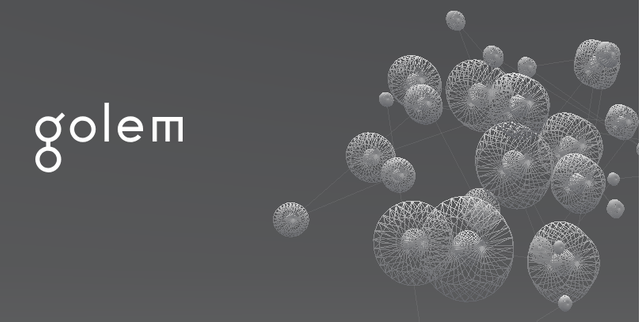
Moreover, Golem comes in handy for managing tasks related to Artificial Intelligence (AI) which requires a lot of computing power. Following the procedure depicted in the photo, the task is divided into several mini tasks and processed by multiple computers, dividing the demand per unit but obtaining a better result once Golem sums up all the parts.
It’s important to note that Golem isn’t a group of servers. The idea is taking advantage of the already existing power in computers and enable users to pay for this service. A single person person could be a consumer of the service (task requester) and a hardware provider, depending on what they need at the moment. The third group that completes the ecosystem are software developers, who can use Golem to distribute their work and potentially monetize it.


For a more detailed explanation of how to submit a task in Golem, check out the following links:

As any trade operation, many different interests intersect in Golem. The requester is looking to pay the lowest rate and get the job done at high quality. They have the power to avoid payment if they obtain mediocre results and even can demand a fair protocol for invalid results. On the other hand, there are the providers who are looking to get the highest price for their service and running the risk of offering lower quality but completing a greater number of tasks. That’s why the protocol devised for the platform needs to be fair and consider both these interests.
The Golem team has already considered the matter and proposed the following procedures to ensure trust and security of the service.
Trust and security:
These target values are supported by two things:
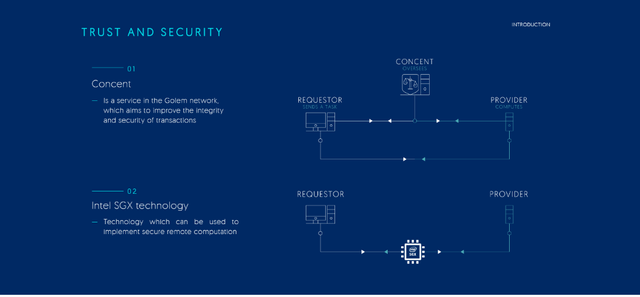
1) Concent.
An optional web service that ensures everything is fair to all the parties involved in a transaction. The correlation between pricing and results must be accurate, and in the case where one party isn’t satisfies, there’s a third party that helps in solving the problem. Concent has special permissions on deposits. To use Concent, both parties must pay a fee in GNT which is then transferred to an Ethereum contract. In the future, Concent will be decentralized too.
"It’s a special type of node in the Golem Network". Source
What Concent does is reinforce communication, as in every task procedure the requester and provider must follow an adequate communication process. If that process is broken by one of them, Concent interviews them and reinforces the communication. If that i doesn’t work, Concent can guarantee that the responsible party assumes full responsibility for the disruption.
Also, Concent performs an additional verification in those cases where the requester declined to pay for a performed task The provider may then demand verification and if its results match the provider’s results, Concent will request a payment from the requester .Even if the requester declines to pay, Concent will charge the payment from their deposit to make sure the platform is fair.
2) Intel SGX security
Security is a must-have in every process. The Golem team takes security seriously, and that’s why they decided to rely on Intel SGX security to ensure secure remote computation.
"SGX is a set of CPU instructions and hardware platform enhancements that enables apps to create private areas within which code and associated data can be stored safe from compromise during execution. If used correctly, this protection measure can prevent data breaches due to attacks from privileged software and hardware attacks." Source
The SGX nodes can be added to Golem to perform the verification in the process. Once the results come in, the data is converted into reference data, and SGX guarantees the privacy of data in Golem and all its processes.
SGX can be used to create a verification process for users and in sensitive data processing.
SGX enclave can be used to secure and seal data, as well as run and host it in every kind of environment, especially in an untrusted one. Becoming a trusted part of the app is a smart move. Once the Intel Attestation Service (IAS) creates a proof of an enclave, the proof can be verified offline. If a user wants to build a solid reputation reputation, IAS is a must. Note that SGX enclaves are restricted to computation only.

The token
Like other projects, Golem has its own token called the GOLEM NETWORK TOKEN (GNT). It's an Ethereum-based token used to pay for services on the platform.
According to the whitepaper, the token distribution corresponds to the following image:


Roadmap
Golem has an unusually large roadmap, but it matches the reach of the project. Here’s Golem’s roadmap:

According to the information shared on their blog, the team is in the Brass Golem Beta 0.17.0 stage, here are the updates about this new version:
"In this iteration, we introduce Netmasking to improve the robustness of Golem’s networking layer and prevent the requesters from getting flooded with too many provider requests. Moreover, we have updated our Blender verification library to reduce the number of false negatives during the verification stage. Finally, we added a new task list to the UI."
So the team is busy working on keeping the roadmap schedule. They’re in the first stage of the roadmap and they have a lot of room to grow and fine-tune this project.

Team
Golem has a team of 13 people, most with in-depth expertise in these and others areas. Together, they make this project possible.

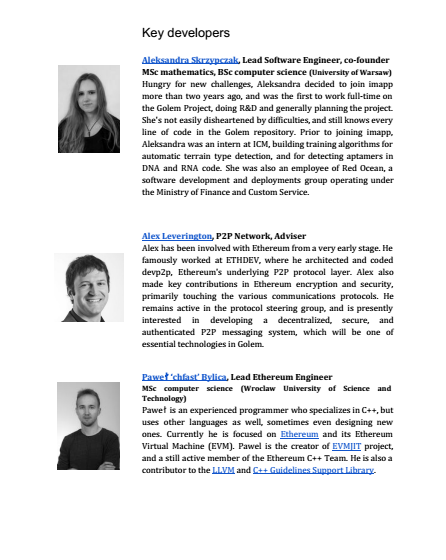
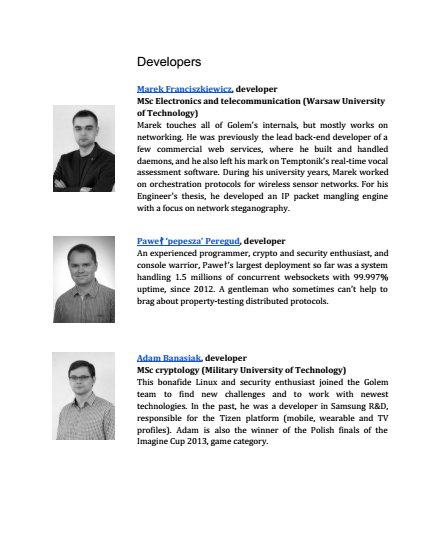
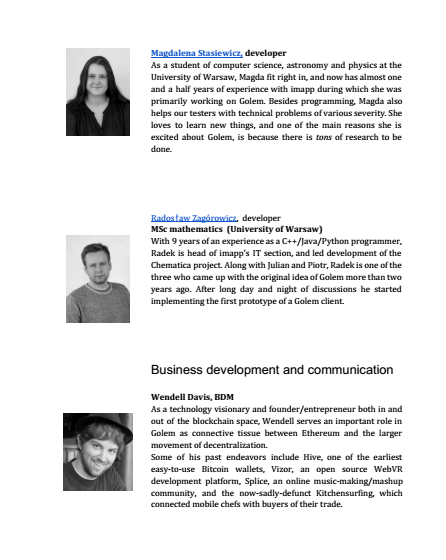

Chain Data Analysis
According to Trivial.co, Golem’s token has 99,544 holders for 1,000,000 tokens, distributed in different percentages. The largest one is 11,17% of the token to a 0,54% plus lower percentages distributed across over 99,000 accounts that hold a 37,21% of the token.
The first operation occurred in November 2016 and the last operation was performed just today September 7th 2018, with a weekly average of 214 and a 30-day average DAU of 184.
According to Coinmarket.com, the current value of GNT is $0,14. The outstanding shares are 959,242,000 of 1,000,000. The market cap is $139,479,823 and trading in more than 50 markets. The following image shows the latest movements of the token.

As you can see, there is continuous movement with a recent peak, perhaps due to the recent release of the latest version. The good thing about this token is that it has a lot of room to grow. It’s a large project so if people want to invest in it, there are plenty of chances to do that and make a profit. After all, the project is still in an early stage.

Competitors
Amazon Web Services (AWS): Amazon offers a group of services to satisfy the demands for computing power, storage, database, migration, networking and content delivery, among others, One of the differences between Golem and AWS is that the latter is an entirely centralized system, with its own team to deliver and create software in the pricing system set by Amazon.
According to experts, AWS is meant to be used by enterprises and large organizations - and Golem comes in handy to those who need more computing power in select cases. Even though they develop almost a similar service, AWS and Golem address different targets.
SONM – Decentralized Fog Computing Platform: they offer a decentralized cloud services Fog Computing Backend in a smart, contract-based marketplace. It’s a very similar project, but with a lower market cap, lower coin supply, and shorter roadmap. SONM pays dividends and Golem doesn’t. Moreover, SONM will support Linux, Windows, MacOs, Android, Play Station and Xbox, while Golem will support only the first three.
Even if they address the same market, there’s a difference between SONM and Golem. SONM is interested in hosting sites besides computing. Both projects are similar in many ways but in my opinion Golem has more significant goals .

Project weaknesses
Just like in every project , there’re some points that may cause people to question investing in the service or using it. Here are the main weaknesses of the project:
The roadmap is too long.
There’s a security issue in the the possibility of information exposure .
Concent may be vulnerable to DDos attacks.
Enclave requires the Intel intervention.
The presence of Intel is required in the attestation of work as well.

Summary
Golem offers an alternative to solving the problem of access to computing power. Golem enables users to help each other by lending the computing power they aren’t using to those who need it to complete demanding tasks - and make some money at it.
No more limits in calculation, no more limits in creation - by using Golem, you get to just do it. And pay a portion to those who are helping you to transform Golem into a genuine decentralized platform that offers microservices. Perhaps this is the next Internet of Things?
I see Golem as a tool for the mind, and our minds are limitless so the applications of Golem are countless, that’s just the beginning….

If you want to now more about Golem, please review the following links

DISCLAIMER: The information contained within this post shall not be taken as financial advice. I am not a financial adviser and none of your investing should be carried out based on any information presented here. You can lose all of your money by investing. The following information is for educational and entertainment purposes only.
Congratulations! This post has been upvoted from the communal account, @minnowsupport, by nowonline from the Minnow Support Project. It's a witness project run by aggroed, ausbitbank, teamsteem, someguy123, neoxian, followbtcnews, and netuoso. The goal is to help Steemit grow by supporting Minnows. Please find us at the Peace, Abundance, and Liberty Network (PALnet) Discord Channel. It's a completely public and open space to all members of the Steemit community who voluntarily choose to be there.
If you would like to delegate to the Minnow Support Project you can do so by clicking on the following links: 50SP, 100SP, 250SP, 500SP, 1000SP, 5000SP.
Be sure to leave at least 50SP undelegated on your account.
@nowonline Pretty good.